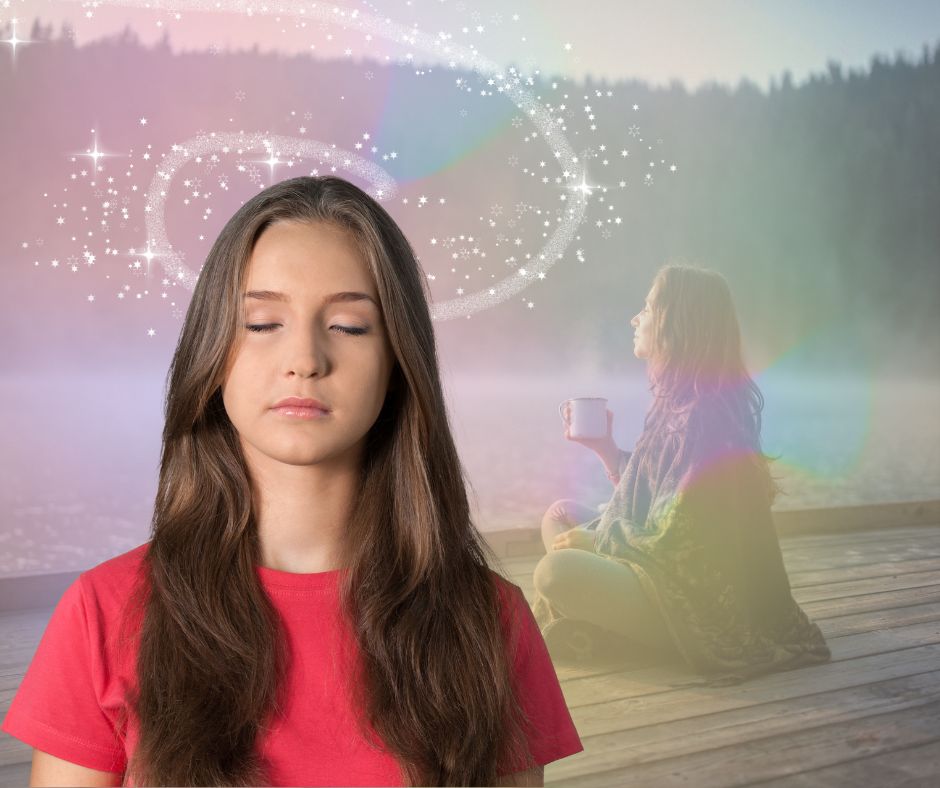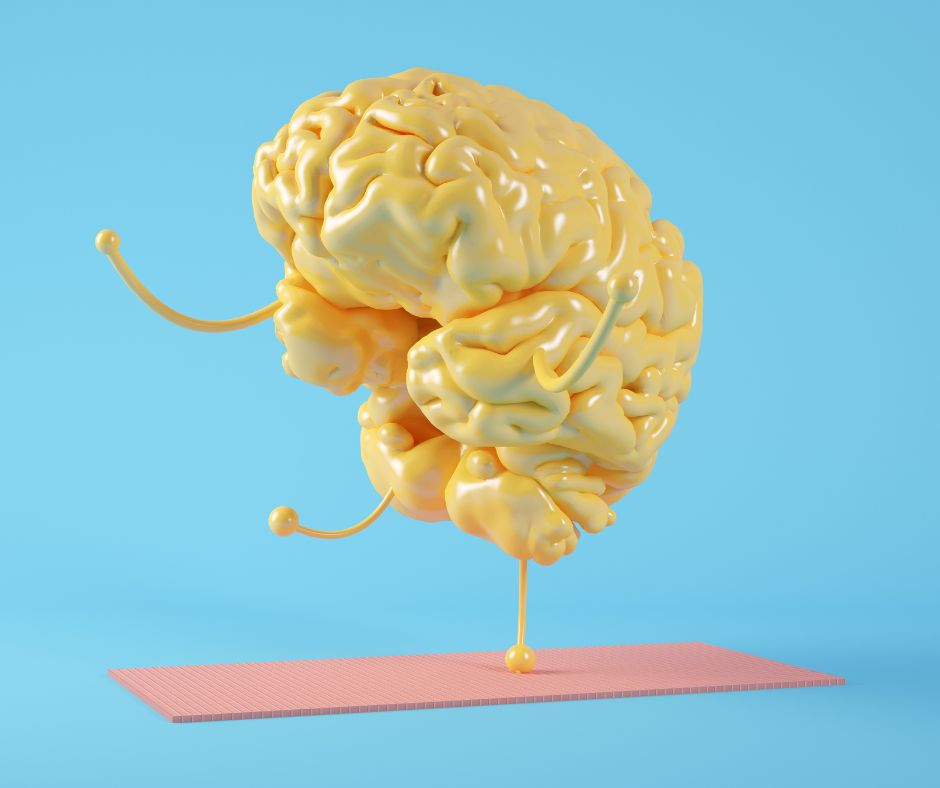What is Visualization?
Visualization, in the realm of relaxation and stress reduction, is a mental practice that involves creating vivid and detailed mental images. It’s the art of using your imagination to conjure up scenes, places, or scenarios in your mind’s eye, often focusing on serene environments, positive outcomes, or calming experiences.
During visualization exercises, individuals engage their senses—sight, sound, touch, smell, and sometimes taste—to construct these mental images. It’s like painting a picture within your mind, where every detail, from the colors and textures to the sounds and emotions, is vividly imagined.
The key essence of visualization lies in its ability to transport you to a mental oasis—a safe, peaceful space that offers respite from the stresses of everyday life. By harnessing the power of imagination, visualization becomes a tool for cultivating relaxation, managing stress, and fostering a sense of calmness and well-being.
Through this intentional mental practice, individuals tap into their creativity to create a mental sanctuary, one where they can find solace, recharge their minds, and navigate through life’s challenges with a renewed sense of tranquility.

How Does Visualization Promote Relaxation And Stress Reduction?
Visualization, often termed as “mind’s eye seeing,” works like a mental movie projector in our brains. When we close our eyes and conjure up a mental image—whether it’s a calming beach scene or envisioning a successful outcome—we’re activating various parts of our brain.
According to an research article published on ScienceDirect “Visualization meditation can cause changes in the neuroendocrine and neuroimmune mechanisms in the body, and the body’s reactions and symptoms resulting from these reactions can be eliminated in situations such as stress that adversely affect the person (Dukic et al., 2021; Jones and Sirault, 2014).“
Creating Vivid Mental Images:
Think of your imagination as a playground where you’re the director, scriptwriter, and lead actor all at once! As you visualize, your brain lights up in remarkable ways. It’s like painting a picture with your thoughts, where every detail, from the color of the sky to the feel of the sand, is vividly imagined.
Engaging Our Senses:
Imagine walking barefoot on soft, warm sand, feeling the gentle breeze caress your skin, and hearing the rhythmic sounds of the ocean. Visualization isn’t just about “seeing” things; it’s about engaging all our senses to make these mental scenes feel real and immersive.
Trick Your Brain into Relaxation Mode:
Here’s the magic: when we visualize a peaceful scenario or a positive outcome, our brains interpret these mental images as real experiences. It’s like giving our brains a sneak peek into a stress-free zone. This triggers our relaxation response, reducing stress hormones and inducing a sense of calmness.
Rewiring the Brain’s Responses:
The more we practice visualization, the more we strengthen certain neural pathways in our brains. This means that by repeatedly imagining these calming scenes, we’re essentially rewiring our brains to respond better to stress triggers, promoting relaxation and emotional well-being.
The Emotional Impact:
Visualization doesn’t just create pretty mental pictures; it influences our emotions too! By imagining positive scenarios or serene environments, we can change our emotional state. It’s like giving ourselves a mini-vacation from worries and stress.
How Visualization Effects Our Brains?

Visualization directly engages various brain regions, including the occipital and parietal lobes responsible for processing visual and spatial information. This mental imagery triggers sensory experiences, activating the brain as if the imagined scenes were real. Additionally, the prefrontal cortex, notably the DLPFC and VMPFC, gets involved, regulating emotions and decision-making during visualization.
The process of imagining calming scenarios or positive outcomes helps regulate the amygdala, reducing its hyperactivity associated with stress responses. This results in decreased stress hormone release and nervous system arousal. With regular practice, visualization strengthens neural connections linked to relaxation while weakening those tied to stress, effectively rewiring the brain’s response to stressors.
Effects of Visualization on Stress Reduction:
1. Relaxation Response Activation:
- Visualization triggers the relaxation response, promoting feelings of calmness. As vivid mental images are created, the brain interprets them as real experiences, activating relaxation-related brain regions.
2. Emotional Regulation:
- Visualization influences emotions by eliciting positive feelings and reducing negative ones. It allows individuals to visualize themselves in peaceful or positive scenarios, modulating emotional responses to stressors.
3. Stress Hormone Regulation:
- Positive visualization lowers cortisol levels, the primary stress hormone. Reduced cortisol secretion decreases physiological stress responses, such as increased heart rate and blood pressure.
4. Cognitive Reframing:
- Visualization assists in cognitive reframing by shifting focus from stressors to calming mental imagery. This cognitive shift promotes a positive outlook and diminishes the impact of stress triggers.
Read also: 12 Superfoods To Supercharge Your Memory

10 Visualization Techniques for Stress Reduction:
1. Beach Visualization Step-by-Step Guide:
- Find a comfortable spot and close your eyes.
- Visualize yourself on a peaceful beach: feel the warmth of the sun, hear the gentle waves, and smell the ocean breeze.
- Imagine the sand between your toes and the relaxation spreading through your body.
Benefits: Instills a sense of calmness and relaxation, reduces tension.
2. Forest Walk Visualization Step-by-Step Guide:
- Close your eyes in a quiet space.
- Picture yourself strolling through a serene forest: notice the rustling leaves, smell the earthy scents, and feel the tranquility.
- Focus on the connection with nature and let go of stress.
Benefits: Promotes mental clarity and emotional stability.
3. Candle Flame Visualization Step-by-Step Guide:
- Dim the lights and sit comfortably.
- Gaze at a candle flame, focusing on its gentle flicker.
- Visualize the flame expanding and engulfing your worries, leaving you with tranquility.
Benefits: Enhances focus, reduces anxiety.
4. Cloud Watching Visualization Step-by-Step Guide:
- Lie down in a comfortable position outdoors or by a window.
- Look up at the sky and observe the passing clouds.
- Visualize your worries drifting away with the clouds, leaving behind a clear sky in your mind.
Benefits: Encourages mindfulness, reduces overthinking.
5. Safe Haven Visualization Step-by-Step Guide:
- Close your eyes and imagine a safe, serene place unique to you: it could be a cozy room or a favorite childhood spot.
- Engage all senses to create a detailed mental image of this haven.
- Spend time in this mental sanctuary, feeling protected and calm.
Benefits: Provides emotional comfort and stress relief.
6. Positive Outcome Visualization Step-by-Step Guide:
- Envision a positive scenario or achievement you desire, imagining it in vivid detail.
- Picture yourself successfully navigating through the situation and experiencing joy.
- Feel the positivity and confidence that this visualization brings.
Benefits: Boosts motivation and optimism, reduces self-doubt.
7. Memory Lane Visualization Step-by-Step Guide:
- Recall a cherished memory from the past that evokes happiness.
- Revisit this memory, reliving the sights, sounds, and emotions associated with it.
- Let the positivity from this memory ease your present stress.
Benefits: Evokes feelings of joy and contentment, reduces tension.
8. Inner Healing Visualization Step-by-Step Guide:
- Close your eyes and focus on your breath, letting your body relax.
- Visualize a healing light or energy entering your body with each breath.
- Imagine this light easing physical and emotional tension, promoting well-being.
Benefits: Facilitates relaxation and aids in physical and emotional healing.
9. Future Success Visualization Step-by-Step Guide:
- Envision your future self achieving your goals or aspirations.
- Picture the journey to success, feeling accomplished and fulfilled.
- Embrace the positive emotions and determination this visualization brings.
Benefits: Inspires motivation, reduces feelings of overwhelm.
10. Mindful Breathing Visualization Step-by-Step Guide:
- Find a quiet space and sit or lie down comfortably.
- Focus on your breath: visualize each inhale and exhale, feeling the rhythm.
- Let go of distracting thoughts, bringing attention back to the breath.
Benefits: Calms the mind, reduces stress hormones.
Harnessing the Power of Visualization for Stress Relief
Visualization emerges as a powerful mental tool, offering a gateway to tranquility and stress alleviation. By tapping into the boundless capabilities of our imagination, we access a realm where mental imagery becomes a refuge from the pressures of daily life.
Through this intentional practice, we’ve unlocked a mechanism within our brains that allows us to create serene mental havens, vividly picturing calming scenes and positive outcomes. The neurological pathways engaged during visualization not only evoke relaxation but also rewire our responses to stress triggers, fostering emotional well-being.
As we immerse ourselves in the art of visualization, envisioning serene landscapes, successful outcomes, and moments of peace, we discover an internal sanctuary, a respite from the chaos. This mental oasis becomes a cornerstone in our quest for balance, enabling us to navigate life’s challenges with a renewed sense of calmness and resilience.
So, embrace the power of visualization as your personalized stress-relief technique. With each vivid mental image, you’re guiding your brain toward tranquility, allowing yourself a moment of respite in the midst of life’s hustle and bustle.


